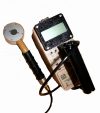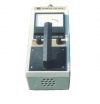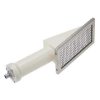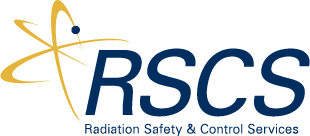Radiation Safety & Control Services also represents the STS 800 Series line of contamination monitor training instruments manufactured by Safe Training Systems (STS). The 800 Series training meters and probes use a harmless perfluorocarbon spray simulant that is detectable by a chemical sensor within the simulator to provide a realistic meter response to a contaminated area. The contaminant spray easily cross-contaminates upon touch and can be “decontaminated” in the same manner as real contamination.
Watch a short video example of Rad Worker Training using the STS800 Series training meter and probe here.
STS 801A Eberline RM-14 Meter

The STS Model 801A consists of a real Eberline RM-14 ratemeter, but with additional STS electronics installed within the case and powered from the Rm-14’s battery supply. The instrument operates using any STS simulated probe containing a gas detection head which detects the presence of the simulant placed on surfaces and clothing The resultant reading is displayed as counts per minute on the RM-14 display.
STS 802 Mini Instruments Model 900 Meter

The STS Model 802 consists of a real Mini Instrument ratemeter, with additional STS electronics installed within the case and powered from the mini’s battery supply. The instrument operates using any STS simulated probe containing a gas detection head which detects the presence of the simulant placed on surfaces and clothing. The resultant reading is displayed as counts per minute on the Mini’s display. Typically, this meter is used with the 44A or EP15 style probes.
STS 804 Ludlum Model 177 Meter

The STS Model 804 consists of a real Ludlum 177 ratemeter, but with additional STS electronics installed within the case and powered from the 177’s battery supply. The instrument operates using any STS simulated probe containing a gas detection head that detects the presence of the simulant placed on surfaces and clothing. The resultant reading is displayed as counts per minute on the Ludlum display.
STS 808 Ludlum Model 3A Meter

The STS Model 808 consists of a real Ludlum Model 3A ratemeter, but with additional STS electronics installed within the case and powered from the Ludlum’s battery supply. The instrument operates using any STS simulated probe containing a gas detection head that detects the presence of the simulant placed on surfaces and clothing. The resultant reading is displayed as counts per minute on the Model 3A’s display.
STS 808B Ludlum Model 3 Meter

The STS Model 808B consists of a real Ludlum Model 3 ratemeter, but with additional STS electronics installed within the case and powered from the Ludlum’s battery supply. The instrument operates using any STS simulated probe containing a gas detection head that detects the presence of the simulant placed on surfaces and clothing. The resultant reading is displayed as counts per minute on the Model 3’s display.
STS 808C Ludlum Model 12 Meter

The STS Model 808C consists of a real Ludlum Model 12 ratemeter, but with additional STS electronics installed within the case and powered from the Model 12’s battery supply. The instrument operates using any STS simulated probe containing a gas detection head which detects the presence of the simulant placed on surfaces and clothing. The resultant reading is displayed as counts per minute on the Ludlum display.
STS 808D Ludlum Model 14 Meter

The STS 808D consists of a real Ludlum Model 14 ratemeter, but with additional STS electronics installed within the case and powered from the Ludlum’s battery supply. The instrument operates using any STS simulated probe containing a gas detection head that detects the presence of the simulant placed on surfaces and clothing. The resultant reading is displayed as counts per minute on the Model 14’s display.
STS Ludlum 2241-2 Meter

The STS Ludlum 2241-1 consists of a real Ludlum Model 2241-2 ratemeter, but with additional STS electronics installed within the case and powered from the Ludlum’s battery supply. The instrument operates using any STS simulated probe containing a gas detection head that detects the presence of the simulant placed on surfaces and clothing. The resultant reading is displayed as counts per minute on the Model 2241-2’s display.
STS Smart Interface Box
The STS Smart Interface Box enables training with any STS simulation probe using an unmodified meter – no simulated meter required. STS simulated probes contain a gas detection head that detects the presence of STS contamination simulant placed on surfaces and clothing. The resultant reading is displayed on the real meter. The interface is made to order with the appropriate meter cable connector. Typical meter models supported include the Electra, Mini 900, Ludlum Model 3, 12, 14 and others. In addition, the interface will connect to any meter from the same model series, providing additional training options.
STS 44A End Window GM Probe

The STS 44A is a replica of a real 44A probe, but with an STS gas detection head rather than a real detector. STS electronics installed within the host instrument power the gas detection system and the signal generated is displayed on the host instrument as counts. The Probe detects the presence of the STS LS1 liquid simulant spray placed on surfaces and clothing.
STS EP15 Probe

The STS EP15 is a replica of a real EP15 probe, but with a STS gas detection head rather than a real detector. STS electronics installed within the host instrument power the gas detection system and the signal generated is displayed on the host instrument as counts. The Probe detects the presence of the STS LS1 liquid stimulant spray placed on surfaces and clothing.
STS BP4 Probe

The STS BP4 is a replica of a real BP4 probe, but with an STS gas detection head rather than a real detector. STS electronics installed within the host instrument power the gas detection system and the signal generated is displayed on the host instrument as counts. The Probe detects the presence of the STS LS1 liquid simulant spray placed on surfaces and clothing.
STS DP2 50 Square Centimeter Probe

The STS DP2 is a real Thermo DP2 probe, but with an STS gas detection head rather than a real detector. STS electronics installed within the host instrument power the gas detection system and the signal generated is displayed on the host instrument as counts. The Probe detects the presence of the STS LS1 liquid simulant spray placed on surfaces and clothing.
STS HP260 Pancake Probe

The STS HP260 is a replica of a real pancake probe, but with an STS gas detection head rather than a real detector. STS electronics installed within the host instrument power the gas detection system and the signal generated is displayed on the host instrument as counts. The Probe detects the presence of the STS LS1 liquid simulant spray placed on surfaces and clothing.
STS HP210 Shielded Pancake Probe

The STS HP210 is a replica of a real shielded pancake probe, but with an STS gas detection head rather than a real detector. STS electronics installed within the host instrument power the gas detection system and the signal generated is displayed on the host instrument as counts. The Probe detects the presence of the STS LS1 liquid simulant spray placed on surfaces and clothing.
STS DP6 100 Square Centimeter Probe

The STS DP6 100 square centimeter is a real Thermo probe, but with an STS gas detection head rather than a real detector. STS electronics installed within the host instrument power the gas detection system and the signal generated is displayed on the host instrument as counts. The Probe detects the presence of the STS LS1 liquid simulant spray placed on surfaces and clothing.
STS 43-5 50 Square Centimeter Probe

The STS 43-5 is a real Ludlum 50 square centimeter probe, but with an STS gas detection head rather than a real detector. STS electronics installed within the host instrument power the gas detection system and the signal generated is displayed on the host instrument as counts. The Probe detects the presence of the STS LS1 liquid simulant spray placed on surfaces and clothing.
STS RadEye DP6 100 Square Centimeter Probe

The STS RadEye DP6 100 square centimeter probe consists of a simulated probe housing STS electronics, battery pack and detection system to connect to any un-modified real Thermo RadEye SX meter using the standard BNC HT probe cable. The STS probe will detect the presence of the STS LS1 liquid simulant spray placed on surfaces and clothing. The smart probe is rechargeable and will automatically turn ‘ON’ when the connected host RadEye instrument is switched on. Cross contamination and decontamination are easily demonstrated. The Probe is currently available in 2 variants: AP2 style and DP6 style.
STS RadEye AP2L 50 Square Centimeter Probe
The STS RadEye AP2L 50 square centimeter probe consists of a simulated probe housing STS electronics, battery pack and detection system to connect to any un-modified real Thermo RadEye SX meter using the standard BNC HT probe cable. The STS probe will detect the presence of the STS LS1 liquid simulant spray placed on surfaces and clothing. The smart probe is rechargeable and will automatically turn ‘ON’ when the connected host RadEye instrument is switched on. Cross contamination and decontamination are easily demonstrated. The Probe is currently available in 2 variants: AP2 style and DP6 style.
STS LS1 Simulant

STS LS1 liquid simulant is used in various ways to demonstrate the spread of radioactive contamination and to enable realistic training in the use of contamination monitoring instruments. In addition, and equally importantly, it is used to simulate decontamination processes. The liquid is dispensed from a small container using an aerosol pump-type dispenser. Depending on the distance from the surface, the application may form droplets or patches of simulant on hard and soft (i.e. fabric) types of surfaces. These patches of contamination are unobtrusive, especially if the surface is not in pristine condition.
STS LS1 liquid simulant is suitable for use on soil, vegetation, vehicles and equipment, and on staff who are wearing protective clothing, including emergency suits, laboratory coats, overalls, rubber gloves etc. The liquid will have no effect on these materials, but permeable clothing, wetted with the liquid should not be allowed to stay in contact with the skin. The simulant is particularly appropriate to simulate alpha radiation, but also effectively used for training in the measurement of surface contamination levels of beta and gamma radiation.
Simulant or ‘contamination’ detection using an STS simulation probe requires that the probe be held near the surface to be monitored. At or below about 0.5cm, the maximum detectable countrate will be achieved, diminishing to zero as the probe moves away from the surface. If the probe is at a proper distance to the surface for detection, but the probe is moved at too high a speed, the simulant may go undetected – like real contamination. Similarly, if the probe is brought in contact with LS1, the probe will become contaminated and emit a continuous signal, as a geiger or scintillator probe would when contaminated with a radioactive contaminant. The discipline of good probe manipulation near surfaces is thus instilled by the system, resulting in good practice by the trainee when set to work.
Decontamination of equipment and protective clothing, vehicles, floors etc., may be demonstrated by washing with water or a water-detergent solution, and both will result in a reduction of countrate, but not necessarily complete cleaning. Use of swabs also results in a reduction in countrate, and in this case it may be demonstrated that the swab has become contaminated during use. Use of decontamination foaming sprays typically result in the complete immediate removal of LS1 from both hard surfaces and fabrics. Scenarios involving the monitoring and subsequent cleanup of spills, of donning and doffing safety equipment and clothing, and of the spread of contamination by accidental contact with contaminated items and floors may be easily staged, and all will have considerable realism.
Depending on the quantity of LS1 spread, the surface texture, temperature and air movements, the apparent radiation will continue to be emitted for up to typically 2-3 hours. As LS1 liquid evaporates, the probe signal reduces to such a minimal detectable level that another training can be repeated in the same area without any concern of detecting a background signal. After approximately 12 hours the area will be completely clean of any residual simulant, having completely evaporated – no additional cleaning required.
STS SS4 Solid Source Material (Single Canister) Simulant

STS SS4 solid source material is used in similar ways to the liquid source LS1, in that it can be spread in the training area on the ground, equipment, protective clothing, etc. without having any effect on these items.
SS4 is a white, loose crystalline powder about the size and consistency of course table salt, which will not adhere to dry surfaces. Therefore, its use is limited to horizontal or near horizontal surfaces and is typically spread over earth or similar granular substrate. Because it is more physically obvious than LS1, some consideration should be given to providing a suitable background against which its presence will not be immediately apparent.
Monitoring is carried out in the same way as is for LS1, and because of the increased surface area of the powder, a larger signal will be obtained. Decontamination may be demonstrated by washing, sweeping etc.
The useful training period by SS4 is about 2 hours for a 0.3g pile of material, after which the signal will decrease, reaching zero cps after about 4 hours. Unlike the LS1 simulant, SS4 leaves behind an inert powder after the signal has completely disappeared which may require further cleanup/removal.
